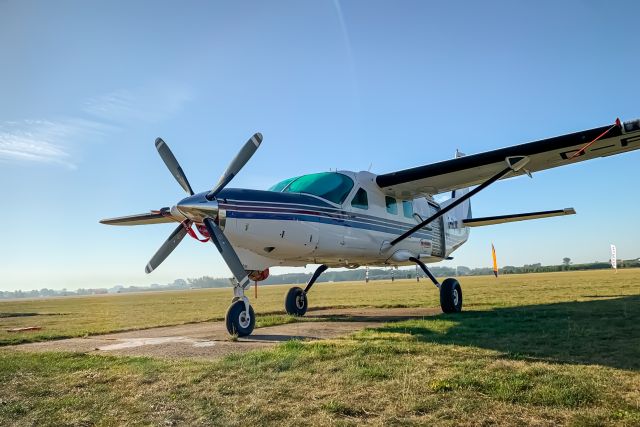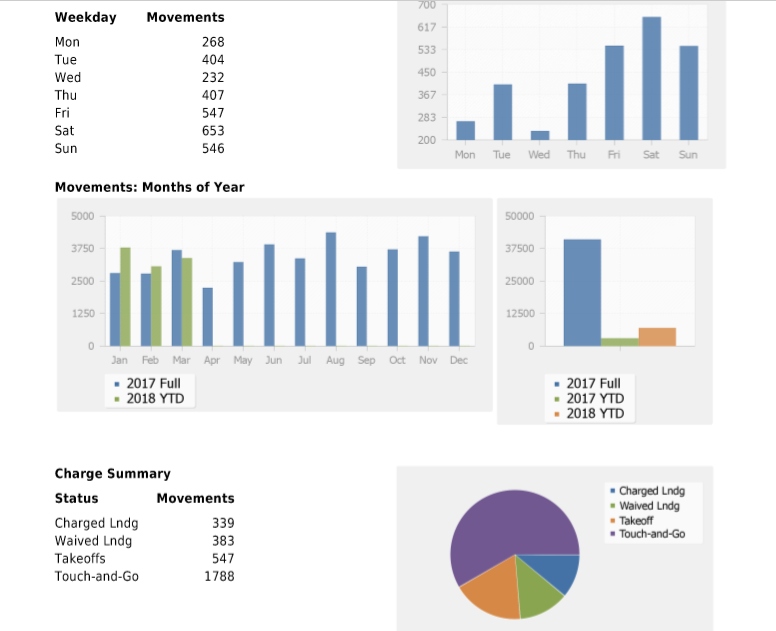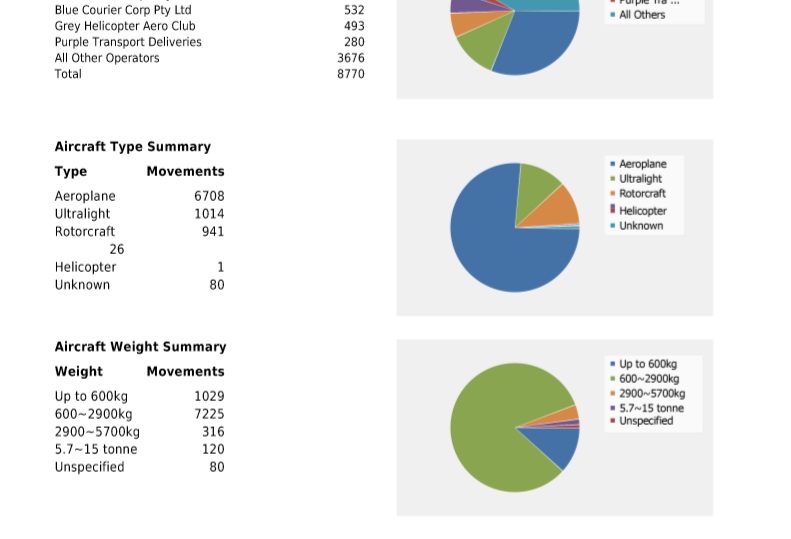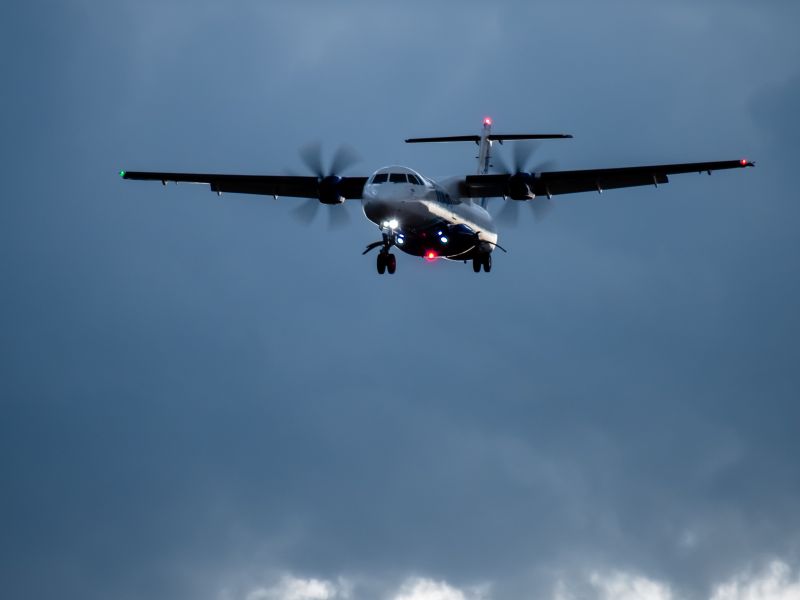
Pricing, Funding, and Revenue Generation.
To make informed decisions, Airport Management needs to know who is doing what and when on their Airport. Aimm provides the information needed for:
- Setting Landing Fee rates
- Funding of Airport maintenance and improvements
- Investor information
- Revenue projections
- Cash Flow estimates
- Grant Applications
- Airport Master Plans
Income from Movements
From the smallest recreational Airfield to
the largest international Airport, airports generate a significant part of their
income from collecting Landing Fees in one form or another.
There can be
a fee for each landing, or a Yearly Bulk Fee / Subscription arrangement for unlimited landings
for particular aircraft, or some combination... but one way or another
when an aircraft touches down then the aircraft needs to pay a share of
the costs of maintaining the facilities.

Landing Fees
Aimm automatically detects the movements at an airport using ADSB for most aircraft, and Pilot Voice calls only need transcribing for the remainder. There is no 'right' or 'wrong' landing fee rate, its up to each Airport to set its own fees after considering its facilities, the costs of providing these, and what it wants to achieve.
Aimm sees statistics from a large number of Airports, and some general observations have emerged:
- Fee Basis: Landing Fees can be specified by Aircraft Type, by Weight Band, by Base fee plus Fees in
Weight Bands, and many combinations. Aimm can handle very complex
fee structures with no problems. But complex fees were
usually set for
historical reasons that are long forgotten, and they confuse pilots leading to
billing queries. "Simple is easy."
When an Airport reviews its fee structure a common simplification is to change to "$xx / Tonne", calculated to the Kg, across ALL aircraft types. Often with a fixed minimum to cover fixed overheads on very small aircraft. This is easy understood by pilots and automatically adjusts the fee for the size of aircraft. Usage of facilities such as car parking, neighbours noise tolerance, administration, Health and Safety etc, all tend to be related to the size of the aircraft and number of passengers. In pre-computer days fees were often in weight bands due to the difficulty of calculating the fee to the exact Kg for each aircraft, but that is no problem for a computer.
When considering changing the fee basis, it is important to discuss with major operators first. They will be supportive if they understand that a change to the fee calculation doesn't have to change the overall fees, and can be cost neutral -- increase -- decrease fees, depending on what $ / tonne you set. Its also possible to set special rates for particular aircraft, or an operators whole fleet.
- Yearly bulk fees: These work well for recreational flyers, but not
for commercial
operators
or flying schools. As time passes, commercial operators
change in size. If they grow, a fixed yearly bulk fee
can leave the airport unable to improve the facilities to meet the increasing
service level required, and if they shrink a fixed fee becomes burdensome.
When a new Aimm Client Airport gets its first monthly reports, it's common to find that their flying schools have grown or shrunk, and a bulk fixed fee is no longer appropriate.
Fees per training session are easy to set up in Aimm, and can be at a non-standard rate, either higher or lower than the casual landing fee. Because computerisation makes fee-per-landing easy to bill, Yearly Bulk Fees are now used less, with more airports moving to fee-per-landing. This avoids time consuming, (and sometimes adversarial), re-negotiations with customers.
- Waived fees: Airfields / Airports that have annual Bulk Fees DO need to know what level of fees they are waiving. E.g. a mid sized Council Airport that has everyone on yearly bulk fees. If they are forgoing $75,000 / year in fees compared to the standard Fee-per-Landing, this puts a value on the service provided. "The Council contributed $75k to support local aviation last year.", and helps the airport management with funding, "Even though we are only collecting $100k a year, we are running a $175k enterprise and so $60k grant to reseal the carpark is a reasonable request." To allow this type of Management analysis, in addition to the actual fee charged (often $0), Aimm reports the standard Retail Fee that would have applied, if not waived (For Aimm clients: Movements -- Archives -- Spreadsheet --- [and specify period] , or see on the monthly 'Dashboard Report' as 'Retail value').
-
Self reporting: Experience at many Airports has
shown that aircraft operators self-reporting passenger numbers and
fees is satisfactory only if the Airport can confirm the number
independently. Otherwise self-reporting numbers become less
accurate over time, as various operator administrators interpret
what is a 'reportable' flight and what is not. If payment depends on
passenger numbers, Aimm has methods of combining that into the landing fee to reduce administration time.
Aimm can handle special fees for specific aircraft, or the whole of an Operator's fleet with automatic detection of aircraft bought / sold.
- Aero Clubs: Clubs often have a long history on the Airport, and a lot of local knowledge. This is a valuable resource, so Airport Management will benefit from having one or two experienced Club members (often past presidents) on the Airport Management and Safety commitees. Both the Club and Management have a strong interest in the quality of the facilities, and maintaining the long term viability of the Airport, so the Club should be closely involved at an early stage in any decisions concerning Landing Fees and other charges.
- Better Usage of Land? Most airports constructed before 1960 have cross runways, to allow for the 'tail dragger' aircraft of the era which needed to land directly into the wind. When cross runway usage has greatly decreased, some airports have been able to temporarily close a cross runway for hay/cropping for a few months, and lease the land to a local farmer. In some cases this has generated more income than the total revenue from landing fees of the whole airport. The Aimm reports identify the usage of each runway and provide evidence of usage level, opening up possibilities to make more efficient use of the land when it would not significantly affect aviation.
Airport Funding
Whether the Airport is generating its own income, or running a
deficit supported by a Council, it needs hard facts and
figures on its changing levels of usage... which parts of the
operation are
expanding? Which contracting? Which types of activity are
running a surplus? Cost neutral? A Deficit?
For an Airport the aircraft movement numbers are the key 'facts and figures' that show what is
happening, so that informed decisions can be made by the Management and
Board / Supervisor. Aimm provides this
information, collated and
summarised where helpful and presented in fine detail where that is useful.
From this information, the manager can see what needs to be done to
service changing levels of demand, and the Board / Supervisor can consider the
long term funding needs, and how those are to be met.
INVESTORS: Those Airports that have (or want) private investment need to show that
they are competent managers with good systems in place to know who is doing that,
when and why. Aimm's monthly reports provide this.


Grant Applications
Airports are an essential long term amenity for a district, and many levels of Government (from Local
Councils on up), have funding for development of infrastructure. For smaller recreational airfields, sponsorship
is often available from local businesses and lottery commissions etc for sporting clubs, like Aero Clubs.
But Funding Organisations get many more applications than they can grant... and the funds usually go to those who
can show that they are informed managers who can make a good case supported by documentation
to show the current level of activity, and credible estimates of
future levels.
Aimm's reports provide the facts, figures, and graphs that show what is happening now and the changes over
time. Some substantial Grants have been obtained by Aimm Client Airports with the supporting documentation
that the Aimm system has provided. We do love to hear the words, "We got the grant, many thanks for your help..."
Airport Master Plans
Airports are often required by legislation to have a 'Master Plan'. This necessarily requires evidence of the actual level of activity now, and how it is changing over time. Aimm provides this in a cost-effective manner, with the cost often covered by the extra revenue collected.

Aimm's Services to Airports
Aimm monitors ALL movements and captures better than 99% of relevant Takeoffs, Landings, Touch-and-Goes at most Airports:
- Airside Personnel Tracker: Who is Airside? Where did they go? When?
- Landing Fees: Cost Effective Billing of Fees
- ADSB, Reports, Statistics and full Data for effective management and reporting
- Regulatory Compliance including CASA (Australia) and CAA (NZ) Part 139 Reporting
- Risk Management, Health and Safety, Incident Investigation
- Complaint Resolution and Noise Management
- Funding for Airports, Revenue generation, Grant Applications, Airport Master Plans.